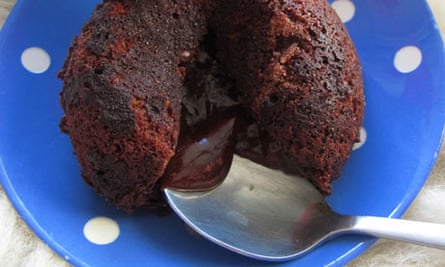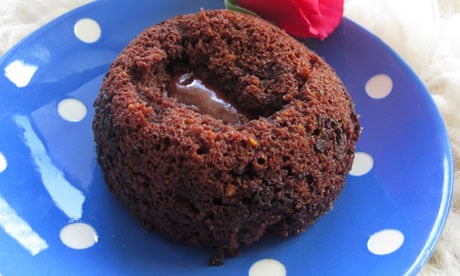There’s a reason why Valentine’s Day menus always end with chocolate. You might know that the route to your beloved’s heart is paved with pork belly or smelly cheese, but I’m willing to bet that even plasticine lothario Wallace doesn’t romp around the bedroom smeared in Stinking Bishop. Cliche or not, chocolate still ticks all the right boxes where most of us are concerned and, like a bad rom-com after a few glasses of wine, it’s peculiarly seductive.
It can’t just be any old dish though; a hefty slice of mud cake or a slab of chocolate bread and butter pudding are more likely to send you both to sleep in front of Love Actually than in each other’s arms – you want something a bit lighter, a little more sophisticated, and a lot more impressive. Cue the fondant.
The downfall of many a MasterChef hopeful, it’s developed what one might be termed a bit of a reputation. However, as long as you’re meticulous about timing, you can’t really go wrong – just make sure you can hear the timer above the mellifluous tones of Mr Barry White. (Fondant, in this context, means melting, rather than the thick sugary mixture used in confectionery – violet creams may be the bee’s knees, but they’re not exactly saucy.)
Is it a cake?
When it comes to “naughty” food, one’s mind automatically turns to Nigella. Every day must be Valentine’s Day in Eaton Square, with the domestic goddess sucking her fingers seductively over the most mundane of meals. She probably makes tuna sandwiches in a silk wrap, so I’m surprised her molten chocolate babycakes don’t come with an age-rating.
The “acceptable face of culinary cute”, they start life much like any cake – butter and sugar creamed together, then combined with beaten eggs, vanilla and flour. So far, so village fete – until you fold the best part of four bars of dark chocolate into the batter. The mixture is divided between 6 pudding moulds, and then goes into a 200C oven for 10 minutes to cook.
The first babycake I invert on to a plate collapses in a muddy mess, as does the second, two minutes later, but after quarter of an hour in the heat, I finally have something to show for my efforts. Spongy and slightly crisp on top, oozy and sweet within, they’re fluffier than I expected; more like the best chocolate pudding never to appear from the school kitchen than anything particularly sophisticated.
Is it a mousse?
Perhaps, I muse, the fondant proper is a job for the French – babycakes seem to be an entirely different proposition, particularly if you ask Google. Despite having been in this country longer than I have, Raymond Blanc still has an accent you could cut with a knife and serve with ze crackers, so his recipe seems as good a place to start again as any.

According to Xanthe Clay in the Telegraph, it’s based on his mother’s chocolate mousse, which I’ve already dissed on these pages, but many months have passed since a mousse passed my lips, so I’m willing to give Maman Blanc another chance.
I whisk together egg whites and fructose (oh, Raymond, how I’ve missed your predilection for pricey fruit sugars) into soft peaks while melting chocolate in a bain marie. I then mix cornflour with a little water to make a paste, and whisk this into the chocolate – which, of course, immediately causes it to seize up in the manner of something you might struggle to scrape from your wellies. Thanks Ray.
With some difficulty, I fold in a third of the egg whites, and then the rest, and then put my slightly streaky mixture into the oven for 7 minutes. Again, the first one isn’t set – perhaps my oven, despite the thermometer, is colder than it claims – but eventually I manage to catch one at exactly the right moment. It’s weird - slightly dry and tough on the outside, and a bit underwhelming flavourwise within.
No, it’s a fondant!

Almost undaunted, I turn to telly Frenchman #2, Michel Roux Jr, for advice. He and Raymond have the same number of stars, but Roux has munched on more overcooked fondants in the company of professional pudding-fancier Gregg Wallace, which might just give him the edge in this particular contest.
He gives his daughter’s recipe, which “never fails to impress” – and having checked her out, and discovered she’s a trainee chef rather than, say, a computer programmer or a midwife, I give it a whirl. Saying that, even if she had decided on an alternative career path, she wouldn’t have had many problems with this recipe – whisk together the eggs, sugar and flour until just mixed (“don’t worry about the odd lump or two!” Papa reassures me), pour in the melted chocolate and butter, fold together, and cook for 10 minutes. I have to give it to her, they’re good – less cakey than Nigella’s, and richer than Raymond’s, I’d even dare to serve this to Michel’s scary minion, Monica.
Or is it?

Someone else who’s eaten their fair share of fondants over the past few years is John Torode, who takes Michel’s place at MasterChef HQ when it’s ordinary folk, rather than culinary professionals, trying to CHANGE THEIR LIVES. His recipe, however, has something to prove about his abilities in the kitchen – as well as melting together butter and chocolate, I must whisk eggs and sugar together over the heat until thick pale and fluffy.
This is probably easier if you have the electric beaters specified by John, rather than just a hand whisk, but still, it’s multi-tasking of the kind which would make great TV. I then stir in the flour, chocolate and butter, and cook for 9 minutes. The texture is moister than Emily Roux’s pudding, and, although smooth, rather heavy. As I set to washing up that extra pan, I’m not convinced the extra effort has been worth it.
Riches aren’t everything
Tamasin Day-Lewis prefaces her hot chocolate pudding recipe in her book Simply the Best in with a story about eating chocolate with Roux Jr at Le Gavroche – with credentials like that, and over twice as many egg yolks, I have high hopes.

I beat together the eggs, yolks and sugar until pale (and thus also rather fluffy, although she doesn’t mention this) and then beat in the melted butter and chocolate and fold in a negligible amount of flour. I must then refrigerate it for at least a couple of hours before cooking. There’s no discernible benefit to this pause as far as I’m concerned – the texture is just the same – but I’m intrigued enough to freeze some of the mixture overnight, and then push it into the middle just before cooking. This tactic is used by Larousse Gastronomique in their rather involved recipe, but I’m unimpressed – a puck of cold mixture in the middle of a hot pudding spoils the moment. I like the lightness that whisking has given Tamasin’s mixture but I find the flavour too rich – perhaps it’s designed for sharing?
Extras
John Torode uses a mix of white and dark chocolate in his fondants, which I think makes them too sweet. I also experiment with cutting down the sugar, and using a proportion of milk chocolate to give a more rounded flavour, but it’s still too sickly – I conclude the recipe needs the clean, slightly bitter flavour of dark chocolate to make it palatable.

Nigella lines her moulds with greaseproof paper to stop the puddings sticking, but I find coating them with butter and cocoa powder, as Gordon Ramsay does, is easier, and gives a nicer looking result.
If you’re hoping to impress, I beg you to do a trial run first to see how long these will take in your oven. There comes a point in a relationship where serving up something that looks like a cow pat is funny – but in my experience, it’s very rarely seductive.
Perfect chocolate fondants

Makes 2
60g unsalted butter, cut into dice, plus extra to grease
1 tbsp cocoa powder
60g dark chocolate, broken into pieces
1 egg and 1 egg yolk
60g caster sugar
1 tbsp plain flour
1. Pre-heat the oven to 200C if cooking immediately, and put a baking tray on the middle shelf. Butter the inside of 2 small ramekins or pudding moulds, and then put the cocoa in one and turn it to coat the inside, holding it over the second mould to catch any that escapes. Do the same with the other mould.
2. Put the butter and chocolate into a heatproof bowl set over, but not touching, a pan of simmering water and stir occasionally until melted. Allow to cool slightly.
3. Vigorously whisk together the egg, yolk, sugar and a pinch of salt until pale and fluffy. Gently fold in the melted chocolate and butter, and then the flour. Spoon into the prepared moulds, stopping just shy of the top – at this point the mixture can be refrigerated until needed, or even frozen, as the puddings will not wait around once cooked.
4. Put on to a hot baking tray and cook for 12 minutes (14 if from cold, 16 if frozen) until the tops are set and coming away from the sides of the moulds. Leave to rest for 30 seconds and then serve in the ramekins or turn out on to plates if you’re feeling confident – they’re great with clotted cream or plain ice cream.
Have you mastered the dish that’s ended so many MasterChef dreams? What’s your method?

Comments (…)
Sign in or create your Guardian account to join the discussion